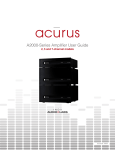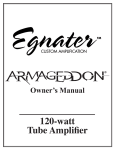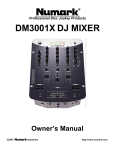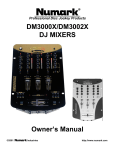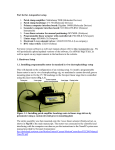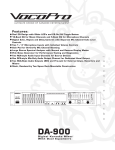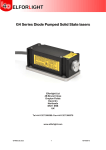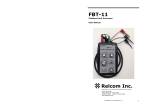Download andrews Para-Dyne 50 Specifications
Transcript
OPERATION MANUAL Head and Combo 11/03/2012 2 Thank you for purchasing an Andrews Amplifier. The Para-DyneTM name is derived from the two-channel dynamic tone of the amp. As with all Andrews amps, these models are built to the highest standards of craftsmanship and are finely tuned for the ultimate tone. This manual will help you to get the most from your new amp. Please feel free to contact us with any questions at andrewsamps.com 3 FEATURES; • 2 CHANNELS OF ALL-TUBE TONE - Selectable by front panel or footswitch, Channel One provides those classic warm yet sparkling clean tones and is a perfect platform for pedal boards while Channel Two gives you a wide range of smooth, sustaining overdrive lead tones. • OPTIONAL BUFFERED SERIAL EFFECTS LOOP – See the rear panel explanation for more information. If effects are to be used on the lead channel at high gain settings, the optional effects loop is recommended. • HAND-WIRED CONSTRUCTION – Also sometimes called “point-to-point” wiring, the Para-Dyne amps utilize a very high quality turret board made of super-tough G10 composite. This glass-epoxy laminate is specified for its extremely high strength and high dimensional stability over temperature. The extra-thick board material will never warp or melt, and there are no copper traces to peal away from the board over time. All wiring and soldering is done by hand and qualitychecked to ensure many years of trouble free operation. • AMERICAN-MADE TRANSFORMERS – We utilize only the best transformers to meet our specifications. They are chosen for superior tone and are rated to withstand extreme heat for high reliability. Output impedance is switchable to 4, 8 or 16 ohms and 2 speaker jacks are provided. • CUSTOM DESIGNED CHASSIS – Our durable welded steel chassis is designed specifically for our amp models so that every part can be mounted in the optimal location for lowest noise and highest stability. • CUSTOM DESIGNED CABINET – Our cabinets are specially designed for maximum durability and superior tone. We use high-grade birch ply for our cabinets. The cabinet components are precision cut using high-tech equipment and are hand assembled with care. Dovetail or finger joints are used at the corners for maximum strength. • SELECTABLE OUTPUT POWER LEVELS – A “triode/pentode” switch is provided to allow the output power to be reduced about half the rated output for those situations when you want a little less volume without sacrificing tone. • EXTERNAL BIAS TEST POINTS – The Para-Dyne amps are equipped with external bias test points and an externally accessible adjustment control. This makes output tube replacement fast and economical. In fact, with a low cost multi-meter you can adjust bias yourself. This can be a real advantage in case of a tube failure during a performance or recording session. See the section about the rear panel for more information. 4 Warnings and Precautions During operation, vacuum tubes can reach temperatures over 400 degrees F. Do not touch hot tubes. Insure plenty of ventilation behind the amp. Keep the amp away from curtains and other flammable objects and children. Do not expose your amplifier to rain. Never set any cups, glasses, bottles or cans of liquid on your amplifier. Do not use any solvents to clean your amplifier. Never operate your amplifier without a proper speaker load or damage may occur. See the section about the rear panel features for more information. Make sure the amplifier is always properly grounded. Never remove or defeat the ground pin from your power cord. Always unplug the amplifier before changing tubes or fuses. Use only correctly rated fuses. See the rear panel and this manual for proper fuse ratings. This amplifier can create high sound pressure levels. Please use proper hearing protection and/or maintain an adequate distance from the amplifier to avoid hearing damage. Tube amps contain lethal voltages (even when unplugged). There are no fuses or other user serviceable parts inside. Please refer servicing to qualified service personnel. Never insert any tool or other object into ventilation holes, tube sockets or other openings unless instructed to do so in this manual. Otherwise, you may come in contact with dangerous high voltages inside the chassis. 5 Front Panel 1. INPUT JACKS – For maximum versatility, we have provided two input jacks (labeled HI and LO). The HI jack provides a bit more drive and sensitivity. The LO jack provides a slight attenuation and is useful when a cleaner and slightly darker tone is desired, especially with high output pickups. 2. VOLUME CONTROL – Use this control to adjust the volume of the clean channel. When not using the footswitch, pull this knob to select the clean channel. When using the footswitch, keep this knob pushed in. 3. BRIGHT SWITCH – This three position switch is used to adjust the balance of brightness (treble) between the clean channel and the overdrive channel. Moving the switch to the down position will remove brightness from the clean channel without affecting the overdrive channel. The middle position provides a more neutral brightness balance and the upper position will add additional brightness to the clean channel. 4. DEPTH CONTROL – The DEPTH control adjusts the depth of the bass for the clean channel. Use it in conjunction with the bass control to balance the bass response of the clean channel vs. the lead channel. In general bass and/or depth should be turned up for playing at lower volumes and down for higher volumes. 5. GAIN CONTROL – This is for adjusting the gain or overdrive of the lead channel. It is used in conjunction with the MASTER VOLUME control. 6. TREBLE CONTROL - This control varies the amount of treble and is effective on both channels. Note that the tone controls are interactive. The treble control’s adjustment range is widest when the MIDRANGE control is not turned up too high. 7. MID CONTROL – The MID control adjusts the midrange frequency levels for both channels. Keep the setting low for vintage American tones. Turn it up for a warmer tone with increased sustain. 8. BASS CONTROL – This control varies the amount of bass on both channels. Use in conjunction with the DEPTH control to balance between the two channels. In general, it is suggested to increase the bass setting as volume is decreased to compensate for the way the human ear hears bass at different volume levels. Bass is generally turned down at high volume settings to keep the low end “tight”. 6 9. MASTER VOLUME CONTROL – Use the MASTER VOLUME control to adjust the loudness of the amp when using the lead channel. Try setting it a little louder than the clean channel and switching to the lead channel for solos. For practicing at low volume, the control is designed to maintain a great overdrive tone when turned down. See additional notes below. 10. STANDBY SWITCH – This switch turns on the high voltage for the tubes. When turning on the amp, make sure the STANDBY switch is in the off (down) position. Turn on the POWER (up position) switch first. The pilot light will light up. Wait at least one minute to allow time for the tubes to warm up completely before turning on the STANDBY switch. After the tubes are warmed up, turn on the STANDBY switch (UP position) to operate the amp. It is a good idea to turn the STANDBY switch off when not using the amp for more than a few minutes. This will quiet the amp and stop the plate current from flowing in the tubes, resulting in longer tube life. 11. POWER SWITCH – This switch turns on the main power to the amplifier. Always turn off the POWER switch when not using the amp for several hours or more. 12. PILOT LIGHT – This light indicates when the main power is turned on. For bulb replacement, simply unscrew the red lens, grab the bulb with your fingers, push in while turning counterclockwise and release. Replace with a standard #47 bulb. The lens thread fits many standard lamp lenses and “jewels” allowing you to customize the color if you desire. Adjustment suggestions – • Try adjusting the tone controls on the overdrive channel first. After achieving your desired settings, switch to the clean channel. Use the BRIGHT and DEPTH switches to balance the lows and highs with the overdrive channel depending on your guitar, effects and volume settings. • When playing the amp at high volume, for example when the MASTER VOLUME is turned up high or when the clean volume is turned up high, a richer sound is achieved with more apparent bass. It is normal for the tone controls to be a bit less responsive in this state since additional harmonics are created in the output stage after the tone controls. The TRIODE/PENTODE switch on the rear panel can be used to drive the output tubes at slightly less volume. 7 Rear Panel 1. FUSES – Always use correctly rated fuses or severe damage to the amp may occur. Refer to the rear panel for fuse ratings. Always unplug the amp before replacing any fuses. When installing a new HV fuse, first insert it into the cap of the fuse holder, then while holding only the cap, insert the fuse into the holder, push in and turn clockwise to lock the cap and fuse in place. The main AC fuse is located in the AC cord jack. Use a small screwdriver to remove the fuse holder. 2. TRIODE/PENTODE SWITCH – In the PENTODE position, the amp will operate normally with full output power. In the TRIODE mode, the output power will be reduced roughly by half. This will allow the volume controls be set higher for a more “cranked up” tone while slightly reducing the actual volume of the amp. Always be sure to stop playing before switching. Operating this switch while playing could cause damage to the amp or tubes. 3. BIAS TEST POINTS AND ADJUSTMENT CONTROL – These are provided to simplify measurement and adjustment of the idle current of the output tubes. Bias adjustment is necessary whenever the output tubes are replaced. See page 10 for bias adjustment instructions and precautions. The adjustment control is located on the underside of the chassis near the test points. 4. SPEAKER JACKS – Always use the jack labeled MAIN first. If an additional cabinet is to be used, meaning that two cabinets will be connected at the same time, connect the second cabinet to the jack labeled EXT. Make sure any speakers you connect can handle more than the output power of the amp. Always set the impedance selector switch to match the correct speaker load. See chart below. NEVER OPERATE THE AMPLIFIER WITHOUT A SPEAKER CONNECTED OR DAMAGE MAY OCCUR AND THE WARRANTY WILL BE VOID. Speaker “Break-In” – New speaker cones may be tight and stiff. This results in a brighter tone with less bass and may even be considered “harsh” at times. By the time your speaker has been played hard for 20 to 30 hours or more, its true character and tone will become apparent. Until your speaker is fully broken-in, you may find that you can achieve better tone by reducing the TREBLE control slightly. 8 5. IMPEDANCE SELECTOR – Always set this switch to the proper speaker load according to the chart below. Note: The Para-Dyne combos incorporates built-in 8 ohm speaker loads so leave it set to 8 when not connecting another cabinet. Setting 4 8 16 For One Cabinet For Two cabinets One 4 ohm cabinet Two 8 ohm cabinets One 8 ohm cabinet Two 16 ohm cabinets One 16 ohm cabinet 6. FOOTSWITCH JACK – Insert the plug from the footswitch cable here. The red LED on the footswitch will glow when in the lead channel mode. For proper operation, make sure the clean channel volume knob is pushed in when using the footswitch. 7. OPTIONAL BUFFERED SERIAL EFFECTS LOOP – Use the loop for connecting effect units such as reverb, delay, tremolo and chorus to avoid the noise and distortion that sometimes occurs when connecting the certain effects in the input jack if using high gain settings on the amp. Effect loops are generally not recommended for overdrive and distortion effects. a) Send – Connect the input of your effects chain here. b) Return – Connect the output of your effect chain here. c) Level – Adjusts the level of the loop signal. For best results, first try the LOW level setting. The LOW will work best for most applications. The HIGH setting may produce slightly less background hiss but is only usable for “line level” effects and may cause distortion or volume reduction under certain conditions, especially when the clean channel volume or overdrive channel gain is set very high. See notes below. d) Bypass – To completely bypass the loop circuit and maintain a 100% tube signal path, set this switch to the “out” position. Notes on the effects loop – Some 9 volt “stomp box” type effects are not designed to be used in effect loops and can not handle the levels present in the loop without distortion. If your effect distorts even when the loop is switched to the LOW level setting, your effect unit may not be compatible. Try upgrading to an effect that can handle higher levels or one that runs on a higher supply voltage. 9 FOR TECHNICAL TYPES We have provided this information for those who have a technical interest, proper equipment and a DYI attitude. CAUTION! GUITAR AMPLIFIERS CONTAIN LETHAL VOLTAGES. If you have any doubt about your ability to safely perform this procedure, refer the job to a qualified technician! Bias Adjustment Procedure: Precautions: Lethal voltages are present inside the chassis and at the tube pins. Do not open the chassis or insert any objects into any openings other than where directed by these instructions. The entire procedure can be accomplished without opening the amp. • Vacuum tubes get very hot. Always allow the tubes to cool completely before touching them. • When replacing output tubes, use only the very highest quality tubes or the amplifier may be damaged. For more details, see the section below regarding tube replacement. Unplug the amplifier and allow the tubes to cool. The output tubes are the two tall tubes on the left side of the amp when viewed from behind. Unsnap or spread open the retaining clips that hold the output tubes in place and remove the tubes. Install a new matched pair of the same type of output tubes that came installed in your amp. i.e. EL34, 6V6 or 6L6 Utilizing a digital multi-meter, set for DC Volts or millivolts measurement and select a range that will show 0-100 millivolts. Insert the black meter lead into the black test point terminal and insert the red meter lead into the red test point terminal. Insert a small flat blade screwdriver into the adjustment control hole and gently turn the control to its mid position. The adjustment control is located on the underside of the chassis near the bias test points. Plug in the AC cord and turn on the amplifier’s main power switch. After waiting at least one minute, turn on the standby switch. The meter should display a few millivolts (mV). While taking care not to touch any hot tubes, insert the screwdriver into the adjustment control slot and very slowly turn the adjustment until the meter reads 65mV for EL34 amps, 75mV for 6L6 amps, 44mV for 6V6 amps and 40mV for EL84 amps. The test point shows the combined reading for both output tubes. It’s a good idea to re-check the bias periodically (every 500 hours of use) as the idle current can drift over time as the tubes age. • 1) 2) 3) 4) 5) 6) 7) 10 TUBE REPLACEMENT Precautions: Always unplug the amplifier and allow the tubes to cool completely before touching them. It is absolutely necessary to adjust the bias when replacing the output tubes. When to replace tubes: 12AX7 preamp tubes will generally last for many thousands of hours but occasionally problems can development before they “wear out”. If you hear crackling, popping, humming, ringing, or other strange noises, try replacing your preamp tubes one at a time. This may resolve the problem. Output tubes usually have a shorter life. They will often start to sound bad long before they fail. If you notice that your amp is gradually loosing volume, headroom or “punch”, or if you notice that low notes are sounding a little “flabby”, it might be time for a new matched set of high quality output tubes. This could happen after a several months or it might take several years depending on how much and how hard the amp is played. Don’t forget about biasing the output tubes. Similar symptoms can be caused by a worn out speaker so be sure to try the amp on another cabinet to be sure. Sometimes a tube will fail before it “wears out”. A tube failure will usually result in blown fuse. If you find a blown fuse in your amp, the most likely cause is a bad output tube. If your amp is blowing fuses, try a new matched set of output tubes and adjust the bias. Always use the correct fuse rating. 11 LIMITED WARRANTY – Valid in USA and Canada only Andrews Amp Lab Inc. warrants this product to be free of defects in materials and workmanship for a period of five (5) years from the original date of purchase to the original purchaser. For subsequent owners, the length of warranty shall be for a period of 1 year from the original date of purchase. During the warranty period, in the unlikely event that a defect occurs, Andrews Amp Lab will at its discretion, repair or replace the product at no charge to you for parts or labor. You must provide a copy of the original purchase receipt in order to receive warranty service. What is covered: • All components other than vacuum tubes and footswitches are covered for the periods listed above. • Vacuum tubes and footswitches are covered for a period of 90 days from the original date of purchase. What is not covered: • Any damage due to abuse, accident, improper AC power, lightening, AC power surge, flood, moisture, rain, solvents and other liquids, fire, smoke, improper connections, improper bias adjustment, improper service, defective tubes not installed Andrews Amp Lab or it’s authorized agent or normal wear and tear • Any amp with altered, defaced or removed serial numbers • Any product that has been altered or modified in any way not authorized in writing by Andrews Amp Lab Inc. • Andrews Amp Lab Inc. shall not be liable for any consequential and/or incidental damages. How to obtain warranty service: Contact Andrews Amp Lab to arrange for service by calling 770-671-0485 or e-mailing [email protected] or check the web at andrewsamplab.com or andrewsamps.com for the latest contact information. After confirming warranty status, send or bring your amp to the location specified. If shipping, you are responsible for the cost of getting the amp to us and we will pay the return shipping costs. Copyright 2006 - 2012 Andrews Amp Lab Inc. All Rights Reserved 12












